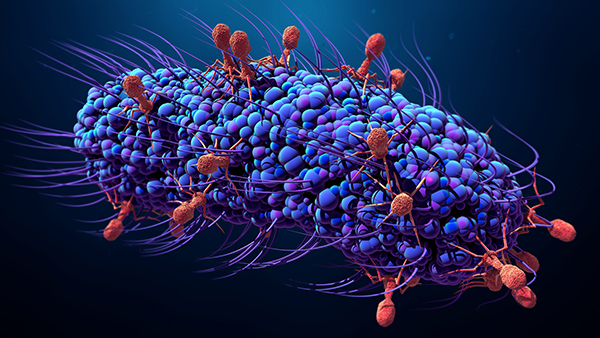Scientists at the University of Otago in New Zealand say they have discovered how viruses that specifically kill bacteria can outwit bacteria by hiding from their defenses. These findings are important for the development of new antimicrobials based on viruses and provide a significant advance in biological knowledge, according to the researchers.

Lead researcher Peter Fineran, PhD, professor, explained that the rise in multi-drug resistant bacteria is leading to the development of alternative therapeutics, including viruses (bacteriophages) that specifically kill bacteria. However, bacteria can become resistant to phages.
Phages are the most abundant biological entities on the planet and are important for global ecosystems, but they can also be used to kill bacterial pathogens, continued Fineran. To defend themselves from the phage invasion, bacteria have developed CRISPR-Cas defense systems, but the phages have come up with ways to avoid these bacterial defenses.
In the study, (“A jumbo phage that forms a nucleus-like structure evades CRISPR–Cas DNA targeting but is vulnerable to type III RNA-based immunity”) published in Nature Microbiology, the University of Otago team discovered a widespread method used by phages to hide from bacterial defenses. They discovered a “jumbo” phage which, as the name suggests, is very big, with hundreds of genes. This phage is not recognized by CRISPR-Cas defenses that would normally cut up the genetic DNA instructions to make many new phages.
“CRISPR–Cas systems provide bacteria with adaptive immunity against bacteriophages. However, DNA modification, the production of anti-CRISPR proteins, and potentially other strategies enable phages to evade CRISPR–Cas. Here, we discovered a Serratia jumbo phage that evades type I CRISPR–Cas systems, but is sensitive to type III immunity. Jumbo phage infection resulted in a nucleus-like structure enclosed by a proteinaceous phage shell—a phenomenon only reported recently for distantly related Pseudomonas phages. All three native CRISPR–Cas complexes in Serratia—type I-E, I-F, and III-A—were spatially excluded from the phage nucleus and phage DNA was not targeted,” the investigators wrote.
“However, the type III-A system still arrested jumbo phage infection by targeting phage RNA in the cytoplasm in a process requiring Cas7, Cas10, and an accessory nuclease. Type III, but not type I, systems frequently targeted nucleus-forming jumbo phages that were identified in global viral sequence datasets. The ability to recognize jumbo phage RNA and elicit immunity probably contributes to the presence of both RNA- and DNA-targeting CRISPR–Cas systems in many bacteria. Together, our results support the model that jumbo phage nucleus-like compartments serve as a barrier to DNA-targeting, but not RNA-targeting, defenses, and that this phenomenon is widespread among jumbo phages.”
“We had molecular and genetic evidence for what was happening, but we really needed to see directly inside these tiny bacteria, which if 100 lined up side-by-side would be the width of a human hair,” said Lucia Malone, a PhD student in the department of microbiology and immunology and first author of the study.

“When phages infected the bacteria, we could see their DNA was encased by a physical ‘shield’ and hidden from the CRISPR-Cas defense systems that couldn’t gain access,” Gumy explained.
However, bacteria have another way to deal with phages. To take over the host, the phages must produce RNA messages that leave the protective compartment of the host. “This is the Achilles heel of these phages and can be destroyed by a special group of CRISPR-Cas defenses that recognize RNA messages,” Malone said.
Fineran explains the study broadens the knowledge of intricate phage-host interactions and demonstrates that jumbo phages are less susceptible to bacterial defense systems than some other phages.
“From a biological perspective, our results provide exciting new insights into how phages evade bacterial defense systems,” he said. “This is important because the rise of the multi-drug resistant bacteria is an issue of global concern, which has led to a renewed interest in using phages as anti-bacterials and jumbo phages may provide excellent therapeutics.”


